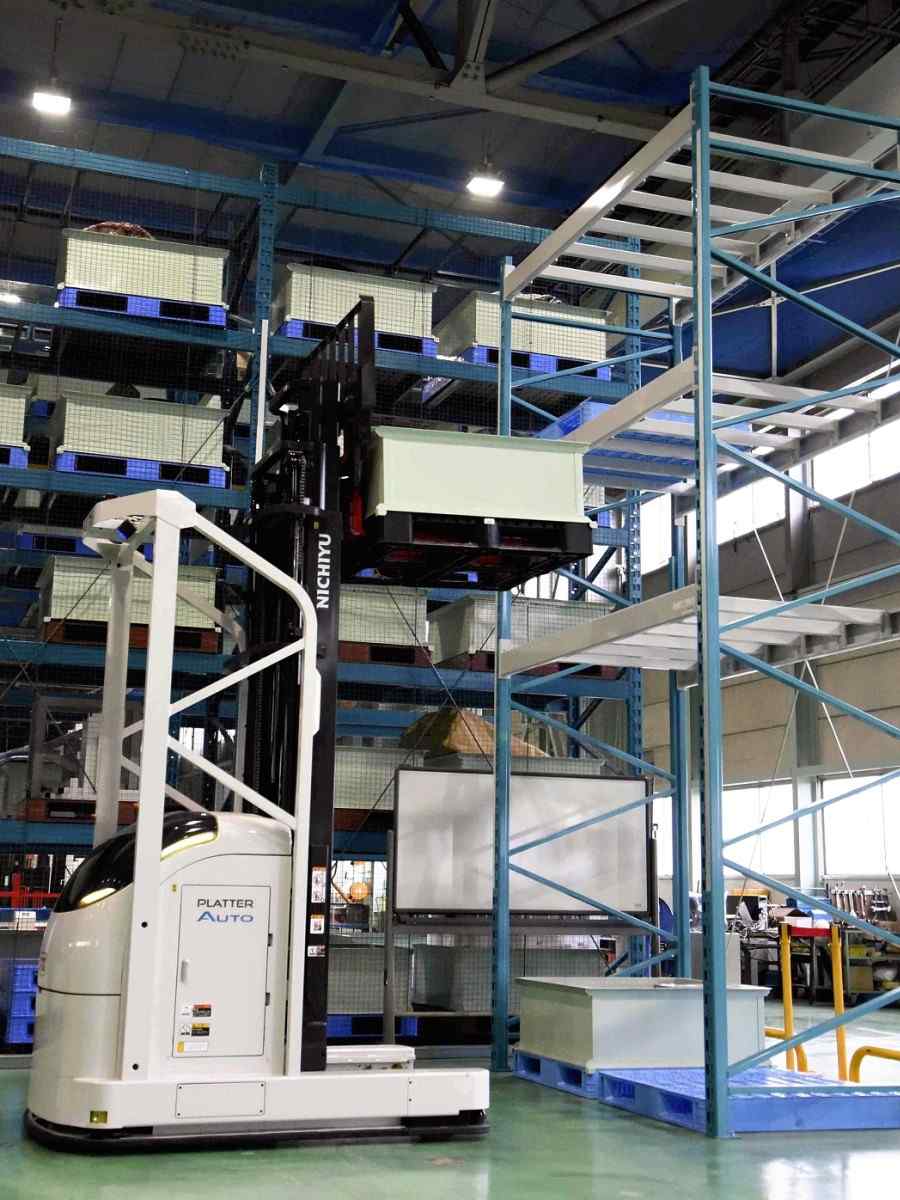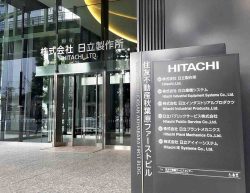Driverless Forklifts to Do Heavy Lifting amid Labor Shortages; Manufacturers Eye AI-Aided Driverless Vehicles

A driverless forklift developed by Mitsubishi Logisnext Co. carries items in Omihachiman, Shiga Prefecture, on March 4.
1:00 JST, March 29, 2024
The development of driverless forklifts is picking up pace as more companies enter the market and businesses embrace a technology tipped to help alleviate the labor shortages looming over many Japanese industries.
In addition to major manufacturers that hold a hefty share of the manned forklift market, new makers are entering the fray in anticipation of greater demand for automated forklifts that can lift and carry heavy loads without a driver at the wheel.
The government will from April start supporting the introduction of these cutting-edge forklifts expected to be a key weapon in combatting the logistics industry’s “2024 problem” — labor reforms that will from April this year limit the number of overtime hours truck drivers can work, a move that has raised fears about a decline in transportation capacity and delays in logistic chains.
Mitsubishi Logisnext Co., a company within the Mitsubishi Heavy Industries Group, unveiled its latest driverless forklift to the media on March 4. Laser equipment affixed to the upper part of the forklift detects reflectors on walls inside the factory to pinpoint the vehicle’s position, which allows it to transport its load to pre-programmed locations smoothly.
Most earlier types of unmanned forklifts moved along a magnetic path embedded in the floor, requiring magnets to be placed along driving routes. The laser-equipped forklifts have two advantages: needing only the reflectors installed on walls to operate and being able to avoid and pass obstacles that block its path.
Some companies have been developing highly autonomous unmanned forklifts that use data from a map.
Last year, Rapyuta Robotics Co., a Tokyo-based company involved in developing robots used in warehouses, put on the market an autonomous forklift that uses sensors and map data to navigate. This model requires neither reflectors nor magnets, while the implementation of artificial intelligence optimizes the movements of multiple forklifts, thereby boosting operational efficiency. Toyota Industries Corp., the world’s largest forklift company, is also developing AI-equipped driverless forklifts.
Dealing with labor shortages has become an urgent priority for many industries in Japan. According to a survey conducted by research company Teikoku Databank in January, 65.3% of companies in the transportation and warehousing industries felt a shortage of full-time regular employees — at least 10 percentage points higher than the average figure reported for all industries.
In many cases, truck drivers also operate forklifts to load and unload items. The new rules that from April will restrict truckers’ overtime to 960 hours per year have stoked fears that the labor shortage in these industries could be further exacerbated.
According to the Health, Labor and Welfare Ministry, about 210,000 people in fiscal 2021 completed the skill training course required to operate a forklift with a load of one ton or more. That number indicates a decline of about 20% from the peak of about 270,000 people who gained the same qualification in fiscal 2007. Demand is growing for automated forklifts that can be used around the clock.
“One of these forklifts can handle the daily workload of 3.5 people,” said an official of Nagatanien Foods Co., which uses a driverless Mitsubishi Logisnext forklift.
However, the high cost of these forklifts remains a stumbling block for many potential customers. Mitsubishi Logisnext’s latest laser forklifts cost about ¥20 million each — about five times the cost of a manned forklift. To alleviate this expense, the Land, Infrastructure, Transport and Tourism Ministry will start taking applications to participate in a demonstration project involving the vehicles and subsidize half of the necessary expenses from April.
Unmanned forklifts operate slowly compared to those with human drivers and sometimes cannot lift materials that are slightly out of position. According to the Japan Industrial Vehicles Association, about 80,000 manual forklifts are sold annually in Japan compared with only about 200 driverless forklifts.
“Ensuring warehouses are easy for forklifts to navigate and improving the precision of those machines will both be essential for facilitating wide use of autonomous forklifts,” said a senior official of the association.
"Business" POPULAR ARTICLE
-

Keidanren Chairman Yoshinobu Tsutsui Visits Kashiwazaki-Kariwa Nuclear Power Plant; Inspects New Emergency Safety System
-

Imports of Rare Earths from China Facing Delays, May Be Caused by Deterioration of Japan-China Relations
-

University of Tokyo Professor Discusses Japanese Economic Security in Interview Ahead of Forum
-

Japan Pulls out of Vietnam Nuclear Project, Complicating Hanoi’s Power Plans
-

Govt Aims to Expand NISA Program Lineup, Abolish Age Restriction
JN ACCESS RANKING
-

Keidanren Chairman Yoshinobu Tsutsui Visits Kashiwazaki-Kariwa Nuclear Power Plant; Inspects New Emergency Safety System
-

Imports of Rare Earths from China Facing Delays, May Be Caused by Deterioration of Japan-China Relations
-

University of Tokyo Professor Discusses Japanese Economic Security in Interview Ahead of Forum
-

Japan Pulls out of Vietnam Nuclear Project, Complicating Hanoi’s Power Plans
-

Govt Aims to Expand NISA Program Lineup, Abolish Age Restriction


























